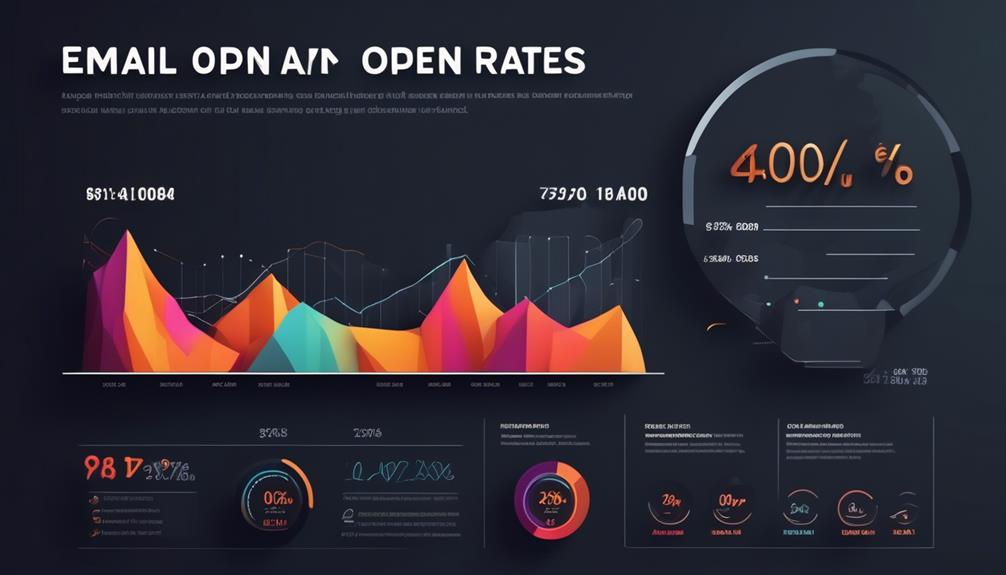Voice-activated email is transforming your communication strategies as audio technology continues to rise. You're not just sending messages; you're engaging with your audience in a whole new way. With smart devices becoming more common, integrating voice commands into your emails can enhance user experience and boost engagement. It's crucial to personalize content to match your brand voice and capture your audience's attention. Paying attention to how your brand name sounds can also improve trust. Ready to elevate your email marketing game? There's plenty more to uncover about this audio revolution that'll keep you ahead of the curve.
Key Takeaways
- Voice technology adoption is rapidly increasing, with 55% of U.S. adults projected to own smart devices by 2022, enhancing email engagement.
- Smart emails allow for voice commands, enabling seamless transactions and personalized content delivery to boost customer interaction.
- Aligning voice characteristics with brand identity fosters trust and improves the effectiveness of communication in voice-activated emails.
- Optimizing for voice search and local SEO is essential to ensure visibility and relevance in an audio-first marketing landscape.
- Effective call-to-action strategies in voice-activated emails should focus on clarity and simplicity to drive user engagement and conversion rates.
Rise of Voice Technology

Have you noticed how voice technology is transforming our daily lives? With around 20% of U.S. adults now owning smart devices like Google Home or Amazon Echo, this trend is only set to grow, reaching an estimated 55% by 2022.
These devices allow you to interact more naturally, reducing reliance on traditional input methods. Thanks to advances in artificial intelligence, the complexity of human speech is being processed with impressive accuracy, making voice commands more reliable. As AI continues to evolve, AI's Impact on Business can further enhance voice-activated features, improving overall user experience.
This shift towards voice technology means you'll find it easier to navigate your digital landscape. Voice search optimization is becoming essential as more people turn to their smart devices for information. By 2024, experts predict there will be 8.4 billion voice assistants in use, highlighting the rapid expansion of this technology across various sectors.
As devices become increasingly integrated into our everyday routines, the market for voice-activated technology is expected to soar. Embracing this audio-first era can enhance your productivity and streamline your tasks, making everyday interactions with technology more efficient than ever before.
Get ready—voice technology is here to stay!
Impact on Email Marketing

Voice-activated technology is revolutionizing email marketing by transforming how brands engage with their customers. With the integration of AI, audio, and video, smart emails can now interact with users' voice-activated devices. This innovation enhances user experience by allowing you to use voice commands for transactions, making it easier and more convenient than ever.
Additionally, brands can explore free crypto opportunities to enhance their offerings and engage tech-savvy consumers.
As you navigate through your inbox, these smart emails cater to your preferences, delivering relevant content that resonates with you. Brands can leverage voice-activated features to create a consistent and trustworthy brand voice that resonates in voice search results. This guarantees that your interactions feel personalized and meaningful.
Moreover, smart emails collect rich data on your behaviors and preferences, enabling businesses to send tailored content like maintenance alerts or performance summaries. This targeted approach not only boosts engagement but also enhances the relevance and effectiveness of email marketing campaigns.
In this new era of digital marketing, embracing voice technology is essential for brands that want to stay ahead. By focusing on your unique needs and preferences, email marketing can evolve into a more interactive and dynamic experience, ultimately fostering stronger brand loyalty.
Brand Personalization Strategies

Personalizing brand interactions is becoming a game-changer in email marketing, especially as voice technology gains traction. By tailoring your emails to customer preferences, you're enhancing the overall customer experience, making it more engaging and relatable. With 70% of consumers favoring a conversational tone, establishing a consistent brand voice across audio and email communications is essential for building trust and recognition.
Here's a quick overview of effective brand personalization strategies:
| Strategy | Description |
|---|---|
| Choose Voice Characteristics | Align voice type (feminine/masculine) with brand identity. |
| Tailored Content | Use customer data to customize email content. |
| Conversational Tone | Adopt a friendly, approachable tone in messages. |
| Clarity and Context | make sure audio content is easily understood. |
| Voice-Activated Features | Integrate voice features for improved interaction. |
Employing these strategies not only boosts engagement—60% of consumers respond better to tailored content—but also increases click-through rates by 50%. Prioritizing personalization in your voice-activated emails can set your brand apart, enriching the customer experience while reinforcing your brand identity.
Addressing Audio Challenges

When you create voice-activated emails, clarity in brand names is essential to how customers perceive your brand.
To enhance user engagement, it's important to acknowledge insights from personality tests that highlight how different individuals process audio information.
You also need to guarantee that your audio content is accessible and that key messages are clear, especially for users relying on screen readers.
Brand Name Clarity
In today's digital landscape, ensuring that your brand name is pronounced clearly is essential for gaining customer trust. With the rise of voice assistants, brand name clarity plays a significant role in customer recognition. A study revealed that 60% of consumers are more likely to engage with brands pronounced correctly by voice technology.
To enhance your audio communications, consider the following factors:
| Factor | Importance |
|---|---|
| Phonetic Characteristics | Helps avoid misinterpretations |
| Consistent Pronunciation | Builds a coherent brand image |
| Rigorous Content Screening | Prevents missed opportunities |
| User Experience | Clear pronunciations enhance satisfaction |
| Customer Loyalty | Consistency fosters trust and long-term engagement |
Accessible Audio Content
Guaranteeing accessible audio content is vital for effective communication in voice-activated emails. When you deliver important information through audio, clarity is key. You need to rigorously screen your email content to avoid misinterpretation.
As highlighted in the email and communication security section, concise messaging helps recipients grasp your intent without confusion. Furthermore, it's imperative to pronounce your brand name clearly. This enhances customer recognition and fosters a positive perception.
Remember, a single voice command guiding users on the next steps can markedly improve their experience. Overloading your audio messages with too much information can lead to misunderstandings.
Also, avoid embedding key messages in images, as users relying on screen readers won't capture that visual information.
Integrating AI technology into your voice-activated emails can elevate the audio experience, but you'll need to invest in hiring skilled talent familiar with voice tech. This guarantees that your audio content not only sounds professional but also meets accessibility standards.
Effective Call-to-Action
Crafting an effective call-to-action (CTA) in voice-activated emails is key to driving user engagement. To achieve this, focus on a single, clear action that eliminates confusion. When users interact through voice, having multiple options can be overwhelming. Ascertain your CTAs are text-based since screen readers and voice assistants won't interpret images, making clarity essential.
A well-structured CTA not only enhances readability but also improves user experience, aligning with the principles of high-quality content.
Use straightforward language that aligns with the conversational tones typical of voice queries. Natural language not only resonates better with users but also enhances comprehension during audio playback. Rigorous screening of your email content is necessary to ensure your CTAs are clear and contextually relevant.
Testing various voice command options can help you determine which phrases best engage your audience. By analyzing real-time feedback and engagement metrics, you can continually optimize your CTAs.
Leveraging Customer Data

Harnessing customer data is essential for businesses looking to enhance their marketing strategies. With the rise of smart devices, you can gather rich insights into user preferences and behaviors. This data allows you to tailor your approach, delivering personalized content that resonates with your audience. Additionally, understanding common financial terms can help you communicate value effectively in your marketing messages.
By integrating data from fitness trackers or other smart devices, you gain real-time insights into user habits. This not only informs your marketing strategies but also enables you to send timely, relevant communications.
Analyzing user engagement with voice-activated features equips you to refine your email content, ensuring it aligns with customer needs and expectations. Voice searches are becoming increasingly popular, and utilizing this trend means you can deliver personalized suggestions and product recommendations based on historical user data.
By focusing on leveraging customer data, you enhance the user experience, leading to increased engagement and higher conversion rates. In today's competitive marketplace, implementing a strategy that prioritizes customer data isn't just beneficial—it's necessary.
Voice Search Optimization Importance

As we shift into an audio-first era, optimizing for voice search becomes essential for your brand's visibility.
The rise of technology has made voice-activated tools increasingly popular, with many users turning to astrology and attractiveness for personalized recommendations.
You need to adapt to longer, more conversational queries that users are likely to employ.
Audio-First Era Shift
Many brands are realizing that the shift to an audio-first era is reshaping how consumers search for information. With the rise of smart assistants, voice search is becoming a primary method for users to access data. This trend demands that you optimize your content for voice queries to stay competitive.
Unlike traditional typed searches, voice searches tend to be longer and more conversational, reflecting natural speech patterns. To effectively adapt, you'll need to focus on long-tail keywords that match how people actually talk.
Empathy-driven design is vital when considering the user's perspective in their search behaviors. Think about the questions users might ask and how they frame them in everyday language. This approach not only aligns with natural language processing but also increases the chances of your content being featured as spoken answers or snippets.
As predictions indicate there will be 8.4 billion voice assistants by 2024, understanding voice search dynamics is essential for your digital marketing strategy. By optimizing for voice search now, you'll improve your visibility and guarantee your brand remains relevant in this evolving landscape.
Embracing this audio-first era is vital for connecting with your audience in a more meaningful way.
Conversational Query Optimization
Voice search is fundamentally changing the way people interact with technology, and optimizing for conversational queries is more important than ever. With the rise of voice-activated devices, users are shifting toward longer, more natural phrases. To connect effectively with them, you need to enhance your content for natural language processing (NLP). This means incorporating long-tail keywords that mirror how users actually speak.
Additionally, understanding the importance of background checks before job offers can help inform the types of content you create, as trust and safety are essential elements in user interactions.
Studies reveal that 90% of people are familiar with voice technology, making it vital for brands like yours to refine your SEO strategies accordingly. Voice search often includes local intent, so local SEO should be a top priority. Verify your Google My Business listings are accurate and utilize local keywords to improve your visibility in search results.
Additionally, using structured data markup can greatly boost the chances of your content appearing in voice search results. This not only helps search engines understand your content better but also positions you to provide direct answers to user inquiries.
Content Optimization Techniques

When optimizing content for voice search, it's important to embrace natural language processing (NLP) techniques that resonate with users' conversational patterns. You should focus on long-tail keywords, which reflect how people speak. This approach enhances visibility in voice search results and aligns your content with the detailed, question-oriented nature of voice queries.
To make your content more effective, structure it to directly address common questions users may ask. This way, voice assistants can deliver concise answers that rank well in voice search. Plus, regularly updating your content keeps it relevant, as fresh information is prioritized by voice search algorithms.
Implementing structured data markup is vital too. It helps search engines understand your content better, increasing the chances of being featured in voice search results. Here's a quick overview of these techniques:
| Technique | Description | Benefit |
|---|---|---|
| NLP Techniques | Aligns with conversational patterns | Improves user engagement |
| Long-Tail Keywords | Detailed, question-oriented phrases | Enhances voice search visibility |
| Structured Data | Helps search engines understand content | Increases chances of featured snippets |
Utilizing these content optimization techniques is fundamental to thriving in the voice search landscape.
Mobile and Site Performance

How can you guarantee your mobile site performs at its finest for voice-activated email interactions? First, prioritize responsive design. This guarantees your site adapts seamlessly across various mobile devices, enhancing the user experience.
If your content doesn't fit well on different screens, you're likely losing engagement and conversion rates. Additionally, consider incorporating themes of positivity and warmth that resonate with users, as this can enhance their overall experience on your site.
Next, focus on fast-loading content. When users initiate voice searches, they expect quick results. If your site takes too long to load, they'll bounce, impacting retention and search rankings.
You can improve loading speeds by minimizing image sizes and avoiding pop-ups—these small adjustments can make a big difference in user satisfaction.
Utilize tools like Google's Mobile-Friendly Test to identify any performance issues. This tool helps you guarantee clear navigation and legible fonts, both essential for an excellent user experience on mobile platforms.
Local SEO Significance

Local SEO is essential for businesses aiming to connect with nearby customers, especially as nearly half of voice search users seek local information.
If you want to capture this audience, optimizing your presence is key. Start by claiming and enhancing your Google My Business listing; this markedly boosts your visibility in local search results and attracts more voice search inquiries.
Incorporating local keywords into your content is another effective strategy. Users often phrase their voice searches conversationally, including location details, so make sure you reflect that in your website text.
Additionally, encouraging local reviews can improve your credibility and influence your rankings in voice search results. Search algorithms favor user-generated content, so actively seek feedback from your customers.
Frequently Asked Questions
What Is Prepare for the Voice Revolution?
To prepare for the voice revolution, you need to embrace voice technology, adapt your communication strategies, and prioritize user preferences. This way, you'll enhance engagement and guarantee your content resonates with modern consumers.
How Do People Feel About Voice-Activated Technology?
You might feel mixed about voice-activated technology. While you recognize its convenience, trust issues and privacy concerns often linger. Many prefer traditional methods, showing skepticism about the effectiveness and reliability of these voice assistants.
What Are the Disadvantages of Voice Assistant?
You might find voice assistants unreliable due to misinterpretations, privacy issues, and accessibility barriers. They can also perpetuate biases, exclude those with speech impairments, and lead to overdependence, impacting your problem-solving skills and technology engagement.
How Do You Develop the Voice for Your Email Campaigns?
You might think developing a voice for email campaigns is hard, but it isn't. Start by defining your brand's personality, then choose a conversational tone that resonates with your audience, fostering engagement and trust.
Conclusion
So, as you sit back and let your voice do the typing, remember: it's not just about telling your email to "write to Mom." You're stepping into a world where personalization means your fridge might know your shopping list better than you do! Embrace the chaos of audio tech, optimize like your life depends on it, and don't forget—if your voice search isn't on point, you might just end up with a pizza delivery to the moon.










